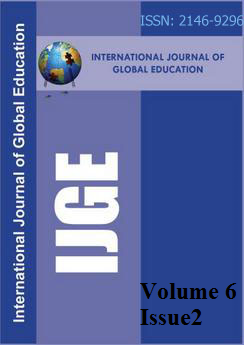
International Journal of Global Education
Yazarlar: Ghada Awada, Abir Abdallah
Konular:-
Anahtar Kelimeler:-
Özet: The present paper reports the results of a study that examined the relative effectiveness of the Glogstereducational tool in improving the speaking proficiency of university students enrolled in Communication Skills class in Lebanon and on increasing their levels of motivation for delivering presentations. The study is based on the assumptions that glogging provides an excellent opportunity for teachers to enhance students’ creativity while conducting and presenting their projects. Descriptive statistics were computed and a series of independent sample and paired samples t-tests and a content analysis of the qualitative data regarding the participants’ perceptions of their glogging experience were carried out. The results of the study indicated that the use of Glogster proved the credibility of the study assumptions. Key words: ESL, Glogster, speaking and presentation proficiency, technology, communication. References Baker, C., & Wills, T. (2013). Have You Used a Glog Yet?. Teaching Children's Mathematics, 19(5), 324-327. Brown, J. S. (2001). Learning in the digital age. In The Internet and the University: Forum (pp. 71-72). Carroll, J., & Edwards, B. (2012). Boys, Ballads and Glogster: Techno-poetry in Year 7. Literacy Learning: The Middle Years, 20(1), 16. Ellis, R. (2003). Task-based language learning and teaching (Vol. 9). Oxford: Oxford University Press. Kent, D. B. (2010). Incorporating Glogster in the University EFL Curriculum.Arab World English Journal, 1(1), 130-170. Larson, L.C. (2010). Digital readers: The next chapter in e-book reading and response. The Reading Teacher, 64(1),15-22. Masi, A., &Winer, L. (2005). A university-wide vision of teaching and learning with information technologies. Innovations in Education and Teaching International, 42(2), 147-155. McCombs, B. L., & Lauer, P. A. (1997). Development and validation of the Learner- Centered Battery: Self-Assessment tools for teacher reflection and professional development.The Professional Educator, 20(1), 1-21. Mitra, A., &Steffensmeier, T. (2000).Changes in student attitudes and student computer use in a computer-enriched environment. Journal of Research on Technology in Education, 32 (3), 417-433. Ohler, J. (2009). Orchestrating the media collage. Challenging the Whole Child, 161. Ray, R. (2013). The Facebook Guide to Small Business Marketing. John Wiley & Sons, Inc. Indianapolis, Indiana. Robinson, P. (2001). Task complexity, cognitive resources, and syllabus design: A triadic framework for examining task influences on SLA. Cognition and second language instruction, 287-318. Roblyer, M. (2003).Integrating Educational Technology into Teaching. (3rd ed.) Upper Saddle River, N.J.: Merrill Prentice Hall. Rodriguez, G., & Knuth, R. (2000). Providing professional development for effective technology use. Pathways to School Improvement. Retrieved from http://www.ncrel.org /sdrs/ areas/ issues/ methods/technlgy/te1000.htm. Sousa, D. A. (2011). How the brain learns. Corwin Press. Swisher, D. J. (2007). Does multimedia truly enhance learning? Moving beyond the visual media bandwagon toward instructional effectiveness. Professional Day for the Kansas State University at Salina. Picardo, Jose. (August 24, 2012). Using Glogster as an Assessment Tool.Box of Tricks: Education and Technology. Retrieved fromhttp://www.boxoftricks.net/tag/glogster/ Valdez, G., McNabb, M., Foertsch, M., Anderson, M., Hawkes, M., &Raack, L. (1999). Computer-based technology and learning: Evolving uses and expectations. NCREL, 1900 Spring Rd., Suite 300, Oak Brook, IL 60523-1480. Viegas, F. B., Wattenberg, M., McKeon, M., Van Ham, F., &Kriss, J. (2008, January). Harry potter and the meat-filled freezer: A case study of spontaneous usage of visualization tools. In Hawaii International Conference on System Sciences, Proceedings of the 41st Annual (pp. 159-159).IEEE. Zawilinski, L. (2009). HOT blogging: A framework for blogging to promote higher-order thinking. The Reading Teacher, 62(8), pp. 650–661.